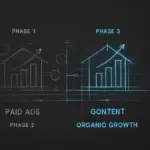My Quarterly ‚System Reset‘: Realigning Goals Across JvG, Mehrklicks, and Iberosattel
The end of the quarter always brings a particular kind of friction: the feeling of having been incredibly busy, yet wondering if all that activity was aimed at the right targets. I oversee an engineering company building solar production lines (JvG Technology), a marketing automation agency (Mehrklicks), and premium saddle brands (Iberosattel). Each demands a different part of my focus, and the risk of context switching is immense. Research in Fast Company suggests this constant shifting can devour up to 80% of our productive time—a staggering loss that impacts not just efficiency, but deep, focused work.
This kind of misalignment isn’t uncommon. A recent Asana study found that only 26% of employees clearly understand how their work contributes to company goals. When you’re the founder steering multiple ships, that lack of clarity starts at the top. If my personal operating system—my habits, focus, and tools—isn’t precisely aligned with the strategic objectives of each business, I become the bottleneck.
To solve this, I don’t rely on sheer force of will or a new productivity app. I rely on a system. Specifically, a quarterly ‚System Reset,‘ a structured 90-day review designed to audit and realign my personal ecosystem with the business systems I manage.
Why a 90-Day Cadence?
Annual goal-setting has always felt arbitrary to me. A year is too long to maintain focus and too short for massive tectonic shifts. The business landscape changes, opportunities arise, and priorities pivot. A 90-day cycle, however, is the sweet spot. It’s long enough to complete significant projects but short enough to adapt to new information.
The data backs this up. Research published in the Quarterly Review Journal shows that 90-day goal cycles have an 81% higher completion rate than annual goals. This cadence creates a natural rhythm of intense focus followed by strategic reflection, preventing the slow drift that dooms yearly resolutions. For me, it turns the abstract concept of „strategy“ into a tangible, 12-week sprint.
My goal is to ensure these systems are interconnected, not competing. My personal system shouldn’t be a separate entity fighting for resources; it should be the engine that powers the operational systems of JvG, Mehrklicks, and Iberosattel. Each has its own demands: JvG requires deep, analytical thinking for complex engineering problems, while Mehrklicks thrives on rapid experimentation with marketing tech. Iberosattel, in turn, needs a focus on brand storytelling and customer experience. The System Reset ensures these different modes of thinking are scheduled and supported, not clashing.
The process is designed to be simple and repeatable, focusing on precise, informed adjustments rather than a complete overhaul. I’ve broken it down into four core steps.
My 4-Step System Reset Framework
This framework is less a rigid checklist and more a mental model for moving from high-level reflection to grounded execution.
Step 1: Disconnect & Reflect
The first step is always to create space. I block out a full day and step away from the operational churn—no email, no Slack, no meetings. I usually start with analog tools, a notebook and a pen, to answer a few key questions:
- What felt hard over the last 90 days? Where was the most friction?
- What created the most energy and momentum? What felt effortless?
- Looking at the top one or two goals for each company, where did my personal efforts align, and where did they diverge?
- What assumption from the last quarter proved to be wrong?
This isn’t about judging performance—it’s about gathering data on my own behavior and the system’s response.
Step 2: Audit & Prune
With those reflections in hand, I conduct an audit focused on simplification. I review my calendar, my task manager, my software subscriptions, and even my recurring meetings. The goal is to identify and eliminate anything that isn’t directly serving the core objectives of the next 90 days.
This is a personal application of a business principle confirmed by Gartner, which found that companies conducting regular system audits improve operational efficiency by up to 30%. I find the same holds true for a personal system. I look for:
- Zombie Projects: Initiatives that have lost their strategic relevance but are still consuming time.
- Tool Overlap: Using three apps when one would do the job better.
- Process Friction: Outdated workflows that create more work than they save. For example, I might analyze our automation frameworks at Mehrklicks to see if they’re still the most efficient solution.
Pruning is essential. You can’t add new priorities to a system that’s already at capacity.
Step 3: Realign & Synthesize
This is where the alignment happens. I take the high-level strategic goals from each company and map them to my personal capacity for the next quarter.
For example, if JvG Technology has a major Q3 goal of finalizing a new solar module production design, my personal system needs to reflect that. This means blocking dedicated „deep work“ time in my calendar for engineering reviews and adjusting my information diet to focus on materials science and manufacturing innovations. My personal goals (e.g., „read one technical paper per week“) become direct inputs for the business goal („finalize the new design“).
I synthesize this into a one-page „Quarterly Brief“ for myself. It lists the one or two keystone goals for each business and the three to five key personal habits or focus blocks required to drive them forward.
Step 4: Document & Execute
An idea without a clear execution plan is just a wish. The final step is translating the Quarterly Brief into my daily operational tools.
The high-level goals from the brief are broken down into concrete projects in Asana. The dedicated focus blocks go directly into my calendar. Key insights and supporting documents get filed away in my personal knowledge management system for easy retrieval.
This closes the loop between high-level strategy and day-to-day action. The System Reset ensures that when I sit down at my desk on Monday morning, the most important work is also the easiest to start.
Frequently Asked Questions (FAQ)
Q1: What if I only run one business? Is this process still useful?
Absolutely. The complexity is lower, but the principle of alignment is identical. The reset would focus on aligning your personal system with your company’s various departments (e.g., sales, marketing, product) or strategic initiatives. The goal remains the same: ensuring your personal energy is directed toward the highest-leverage activities.
Q2: How much time does a System Reset take?
I dedicate one full, uninterrupted day each quarter. The first time might take longer as you build the habit, but the process becomes more efficient over time. The one day invested saves weeks of misdirected effort, making it one of the highest-ROI activities I do.
Q3: What are the essential tools for this process?
The tools are secondary to the thinking, but here’s what I use:
- For Reflection: A simple notebook and a good pen.
- For Goal Tracking: A centralized dashboard to see cross-company KPIs.
- For Execution: A task manager (like Asana or Trello) and a digital calendar.
- For Knowledge: A second brain/PKM system (like Notion or Obsidian).
Q4: What’s the biggest mistake to avoid when starting?
Trying to change too much at once. The reset isn’t about becoming a new person every 90 days. It’s about making small, deliberate course corrections. Focus on identifying the one or two biggest points of friction and the most critical alignments needed for the next quarter. Small, consistent adjustments compound into massive results over time.




